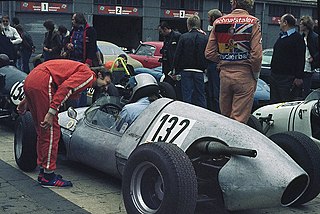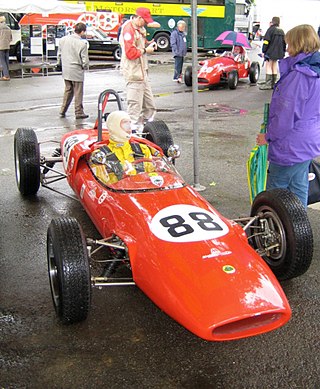
Vanwall was a British motor racing team and racing car constructor that was active in Formula One during the 1950s. Founded by Tony Vandervell, the Vanwall name was derived by combining the name of the team owner with that of his Thinwall bearings produced at the Vandervell Products factory at Acton, London. Originally entering modified Ferraris in non-championship races, Vanwall constructed their first cars to race in the 1954 Formula One season. The team achieved their first race win in the 1957 British Grand Prix, with Stirling Moss and Tony Brooks sharing a VW 5, earning the team the distinction of constructing the first British-built car to win a World Championship race. Vanwall won the inaugural Constructors' Championship in Formula One in 1958, in the process allowing Moss and Brooks to finish second and third in the Drivers' Championship standings, each winning three races for Vanwall. Vandervell's failing health meant 1958 would be the last full season; the squad ran cars in a handful of races in the following years, but finished racing in 1961.

Formula Three, also called Formula 3, abbreviated as F3, is a third-tier class of open-wheel formula racing. The various championships held in Europe, Australia, South America and Asia form an important step for many prospective Formula One drivers.

The Porsche 804 is a single-seat, open-wheeled racing car produced by Porsche to compete in Formula One (F1). It raced for a single season in 1962 in the 1½ litre formula.

Formula Junior is an open wheel formula racing class first adopted in October 1958 by the CSI. The class was intended to provide an entry level class where drivers could use inexpensive mechanical components from ordinary automobiles. The idea to form the new class came from Count Giovanni "Johnny" Lurani who saw the need of a class for single-seater racing cars where younger drivers could take their first steps. It is often speculated that this class was founded as a reaction to Italy's lack of success in the 500cc Formula Three, and although Italian marques dominated the first year of the formula, they were soon overtaken by British constructors.

The Lotus 32 was a Formula 2 racing car built by Team Lotus in 1964. It was developed from the Lotus 27 Formula Junior model. Twelve cars were produced, four of which were run by Ron Harris Team Lotus, whose drivers included Jim Clark and Mike Spence. Spence won the 1964 Autocar British Formula 2 Championship while Clark was fourth in the Trophées de France Championship.

Elva was a sports and racing car manufacturing company based in Bexhill, then Hastings and Rye, East Sussex, United Kingdom. The company was founded in 1955 by Frank G. Nichols. The name comes from the French phrase elle va.

Team Lotus was the motorsport sister company of English sports car manufacturer Lotus Cars. The team ran cars in many motorsport categories including Formula One, Formula Two, Formula Ford, Formula Junior, IndyCar, and sports car racing. More than ten years after its last race, Team Lotus remained one of the most successful racing teams of all time, winning seven Formula One Constructors' titles, six Drivers' Championships, and the Indianapolis 500 in the United States between 1962 and 1978. Under the direction of founder and chief designer Colin Chapman, Lotus was responsible for many innovative and experimental developments in critical motorsport, in both technical and commercial arenas.

The Lotus 48 was a Formula 2 racing car designed by Colin Chapman and Maurice Phillippe and powered by a 1,600 cc (98 cu in) Cosworth FVA engine. It won three races in the hands of Jim Clark but was generally uncompetitive against rival machinery. Ultimately, its main claim to fame is as the car in which Clark was killed at Hockenheim on 7 April 1968.

Turner Sports Car Company Limited was a 1950s British sports car manufacturer, that closed in 1966.

The Lotus 18 was a race car designed by Colin Chapman for use by Lotus in Formula Junior, Formula Two, and Formula One.

The Brabham BT49 is a Formula One racing car designed by South African Gordon Murray for the British Brabham team. The BT49 competed in the 1979 to 1982 Formula One World Championships and was used by Brazilian driver Nelson Piquet to win his first World Championship in 1981.

The Lotus 23 was designed by Colin Chapman as a small-displacement sports racing car. Nominally a two-seater, it was purpose-built for FIA Group 4 racing in 1962–1963. Unlike its predecessors Lotus 15 and 17, the engine was mounted amidship behind the driver in the similar configuration developed on Lotus 19.

The Ferrari 156 was a racing car made by Ferrari in 1961 to comply with then-new Formula One regulations that reduced engine displacement from 2.5- to 1.5-litres, similar to the pre-1961 Formula Two class for which Ferrari had developed a mid-engined car also called 156 F2.

Lotus 20 was a Formula Junior car built by Lotus for the 1961 season as a successor to the Lotus 18.

The BRM P261, also known as the BRM P61 Mark II, is a Formula One motor racing car, designed and built by the British Racing Motors team in Bourne, Lincolnshire, England. The BRM P261 was introduced for the 1964 Formula One season, and its design was an evolution of Tony Rudd's one-off BRM P61 car of 1963. The P261 had a relatively long racing career; variants of the car were still being entered for Formula One World Championship Grands Prix as late as 1968. During the course of their front-line career, BRM P261s won six World Championship races, in the hands of works drivers Graham Hill and Jackie Stewart, and finished second in both the Drivers' and Constructors' Championship standings in 1964 and 1965. Stewart, Hill and Richard Attwood also used works P261s to compete in the Tasman Series in 1966. The BRMs dominated, with Stewart winning four, Hill two, and Attwood one of the 1966 Tasman Series' eight races. Stewart also won the title. The works-backed Reg Parnell Racing team returned in 1967 with Stewart and Attwood, where Stewart added another two wins to his tally. In terms of races won and total championship points scored, the P261 was the most successful car in BRM's history.

The Honda RA271 was Honda's first Formula One racing car to enter a race. The chief engineer on the project was Yoshio Nakamura, with Tadashi Kume in charge of engine development. It was driven in three races during 1964 by American driver Ronnie Bucknum.

The Brabham BT3 is a Formula One racing car. It was the first Formula One design to be produced by Motor Racing Developments for the Brabham Racing Organisation, and debuted at the 1962 German Grand Prix. The Brabham BT3 was the vehicle with which team owner – then two-time World Champion – Jack Brabham, became the first driver ever to score World Championship points in a car bearing his own name, at the 1962 United States Grand Prix. The following year Brabham also became the first driver ever to win a Formula One race at the wheel of an eponymous car, again driving the BT3, at the 1963 Solitude Grand Prix. The BT3 design was modified only slightly to form the Tasman Series-specification Brabham BT4 cars.

The Cooper Mark IV was a Formula Three, Formula Two and Formula One racing car designed and built by the Cooper Car Company at Surbiton, Surrey, England, in 1950.

The Ferrari 412 S was a unique sports racing car produced by Ferrari in 1958. The 412 S combined Ferrari's most powerful V12 engine to date with a one-off experimental racing chassis. It was also incorrectly called as the 412 MI due to being built around an engine from the 500 Miles of Monza racer. The car was created specifically for John von Neumann to take on the American racing cars Scarabs in SCCA racing. Its famed drivers included Phil Hill and Richie Ginther.

William George Sadler designed, built, and drove his own sports racing cars, some of which anticipated the later Formula 5000 and Can-Am cars. He left racing and earned a Masters of Electrical and Electronics Engineering, then went on to design and build light aircraft and aircraft engines, and was involved in the early development of Unmanned aerial vehicles (UAVs).




















